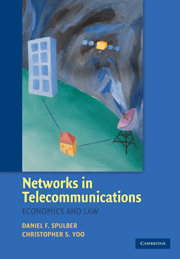Book contents
- Frontmatter
- Contents
- Preface
- Acknowledgments
- Introduction
- PART I THE ECONOMICS OF NETWORKS
- PART II THE REGULATION OF NETWORKS
- PART III POLICY APPLICATIONS
- 8 The Regulation of Local Telephone Networks
- 9 Antitrust as Applied to Network Industries
- 10 The Regulation of Last-Mile Broadband Networks
- 11 The Regulation of Broadband Networks and the Internet: Network Neutrality versus Network Diversity
- 12 The Regulation of Broadband Networks and the Internet: Network Neutrality versus Network Capacity
- Conclusion
- Bibliography
- Index
- Table of Cases
9 - Antitrust as Applied to Network Industries
Published online by Cambridge University Press: 05 June 2012
- Frontmatter
- Contents
- Preface
- Acknowledgments
- Introduction
- PART I THE ECONOMICS OF NETWORKS
- PART II THE REGULATION OF NETWORKS
- PART III POLICY APPLICATIONS
- 8 The Regulation of Local Telephone Networks
- 9 Antitrust as Applied to Network Industries
- 10 The Regulation of Last-Mile Broadband Networks
- 11 The Regulation of Broadband Networks and the Internet: Network Neutrality versus Network Diversity
- 12 The Regulation of Broadband Networks and the Internet: Network Neutrality versus Network Capacity
- Conclusion
- Bibliography
- Index
- Table of Cases
Summary
Antitrust courts have played a pivotal role in shaping the telecommunications industry, most significantly through the private antitrust suits brought against AT&T by MCI and the predecessor to Sprint in the 1970s and the case brought by the federal government against AT&T that culminated with the breakup of AT&T in 1984. All three of these cases relied upon the essential facilities doctrine, which requires owners of bottleneck elements unavailable elsewhere in the marketplace to make those elements available to competitors on reasonable terms.
The essential facilities doctrine has proven quite controversial, inspiring a welter of largely critical commentary challenging its conceptual validity, its administrability, and the extent to which it actually benefits consumers. After years of signaling ambivalence about the doctrine, the Supreme Court once again returned to the subject in Verizon Communications Inc. v. Law Offices of Curtis V. Trinko, LLP. Although the Court found “no need either to recognize…or to repudiate” the doctrine, it endorsed many of the criticisms advanced in the commentary (540 U.S. 398, 411 (2004)).
Most striking is the language in Trinko questioning the antitrust courts' institutional competence to implement access remedies. Since the opinion was issued, courts and commentators have struggled to determine how broadly to read this language. Some have suggested that the presence of a regulatory regime leaves no role for antitrust courts. Others have read Trinko more narrowly, arguing that the scope of judicial authority depends on a more nuanced assessment of the nature of the regulatory regime.
- Type
- Chapter
- Information
- Networks in TelecommunicationsEconomics and Law, pp. 282 - 333Publisher: Cambridge University PressPrint publication year: 2009

